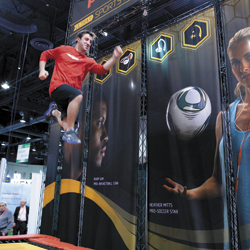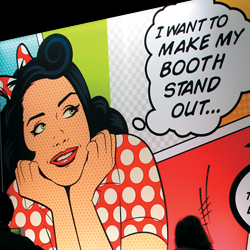exhibitor q & a |

|
Green Graphics
 We use myriad types of graphics in our exhibit- and event-marketing programs. In an effort to be more eco friendly, the next time we replace our graphics I'd like to trade our traditional substrates for Greener versions. What are some of the most common Green options? We use myriad types of graphics in our exhibit- and event-marketing programs. In an effort to be more eco friendly, the next time we replace our graphics I'd like to trade our traditional substrates for Greener versions. What are some of the most common Green options?
 Let me first offer you a big (and Green) thumbs up for trying to create more eco-friendly graphics. After all, in many cases, graphics cover or comprise a majority of your exhibit structures, and they're typically replaced - and discarded in a landfill - far more often than other exhibit elements. So even small steps to Green your graphics can have a significant, positive impact on Mother Nature. Let me first offer you a big (and Green) thumbs up for trying to create more eco-friendly graphics. After all, in many cases, graphics cover or comprise a majority of your exhibit structures, and they're typically replaced - and discarded in a landfill - far more often than other exhibit elements. So even small steps to Green your graphics can have a significant, positive impact on Mother Nature.
And luckily for you, there are several eco-conscious substrate options available today, making it relatively easy to trade your "brown" graphics for Green ones. What's more, some Green substrates actually cost less than their brown counterparts, which means going Green can save you some green in the process.
Here is a quick primer on five of the most popular Green substrates available today. Just about any exhibit house or graphic supplier should be able to provide these options upon request, and most are available through multiple substrate providers. In case you want to learn more, at least one substrate provider's website is also included for each option.
1. Honeycomb Boards (e.g., BioBoard and Falconboard) (www.plyveneer.com, www.falconboard.com)
Honeycomb boards, such as BioBoard and Falconboard, are paper-based lightweight alternatives to Gatorboard and Foamcore. Made from renewable resources and/or with post-consumer-waste content, Falconboard and BioBoard are 100-percent recyclable, unlike most graphics substrates.
The hard, flat nature of BioBoard and Falconboard sheets offers an excellent surface for printing, and since their interiors are made of a corrugated paper, they can easily be cut, joined, and drilled with traditional tools and fasteners. Standard sheets are typically available in 4-by-8- and 4-by-10-foot sizes, and can be made up to 0.47 inches (12 millimeters) thick. Larger sizes and thicknesses can often be custom made.
The key benefits of Falconboard and BioBoard are their bright-white surfaces, which easily accept printing, along with their low cost. A 0.5-inch piece of Falconboard, for example, typically costs 34 percent less than a similarly sized piece of Gatorboard.
2. Jet 220 (www.dickson-coatings.com)
If you're looking for a suitable replacement for vinyl banners, Jet 220 (part of Dickson Coatings' EverGreen Fabrics line) is a decent option. Granted, Jet 220 can only be used single sided (if you want a double-sided graphic, you'll need to sew two pieces together back to back), and you can't heat weld pieces together like you can with vinyl banners. However, it's free of PVC, phthalates, and phosphates, all of which are harmful to human health and the environment.
Plus, Jet 220 uses 50 percent less raw materials than traditional banner materials, it's recyclable, there are no VOCs created during its manufacture, and the manufacturing process uses 80 percent less energy than that of traditional banner materials.
A lightweight, fire-retardant fabric, Jet 220 is available in 13- or 14-ounce weights, and up to 124 inches wide; rolls can include up to 198 feet of material. Its main drawback, however, is that it costs roughly six times that of standard vinyl banner materials.
3. Styrene (www.piedmontplastics.com)
An alternative to laminated graphics, which typically comprise nonbiodegradable, nonrecyclable material, Styrene is 100-percent recyclable.
Rather than encapsulating your graphics in laminate, you can print on the Styrene. Just as with laminated surfaces, Styrene allows you to bring your images and text all the way out to the edges of the graphic (as opposed to enclosing it in a frame of some sort). However, Styrene remains flexible enough to roll and ship, and can be used as an insert graphic between two sheets of Plexi, for example.
Compared to encapsulated graphics of a similar size and thickness, Styrene will usually cut your costs by about 40 percent. While you can get sheets in 4-by-8- and 4-by-10-foot lengths, Styrene also comes in rolls of practically any length. It's available in 0.02- and 0.03-inch (0.5- to 0.75-millimeter) thicknesses, the latter of which is best for flatbed (direct printing) use.
4. Showcard (www.montroy.com)
Showcard (aka card stock) is simply paper stock that is thicker and more durable than normal paper, but thinner and more flexible than other forms of paperboard or foam board. Showcard is often used for business cards, postcards, playing cards, etc., but it can also be used for posters, indoor signage, framed signage, etc. The texture is usually smooth, but surfaces can be ordered as textured, metallic, or glossy.
Showcard is a decent, biodegradable alternative to Foamcore, which doesn't biodegrade for hundreds of
years and is resistant to photolysis. While it costs twice as much as Foamcore, it's water soluble and 100
percent biodegradable and/or recycl-
able, and it meets Sustainable Forestry
Initiative Standards for Land Management and is endorsed by the Wood Procurement Programme for the
Endorsement of Forest Certification (PEFC). Available in 5-by-8-foot sheets (with custom sizes available), Showcard typically measures up to one-sixteenth of an inch thick.
5. Coroplast (www.coroplast.com)
A corrugated plastic sheet, Coroplast is a decent alternative to standard outdoor graphics as well as various types of rigid signage. It only costs about 5 percent more than typical outdoor-suited materials, and it's 100-percent recyclable. Furthermore, Coroplast can be easily stored for repeated long-term use.
Standard 4-by-8-foot sheets, which are 0.25 inches thick, can be modified with: ultraviolet protection, anti-static treatment, flame-retardant treatment, custom coloring, etc. Tougher than corrugated fiberboard and lighter than an extruded plastic sheet, Coroplast is good for indoor and outdoor use, and its surface is well suited to various printing techniques.
So when it's time to buy a new set of graphics, ask your supplier about one of the aforementioned substrates. Some of these options will also help cut costs, but all of them will help make Mother Nature happy.
- Kristopher Truscott, national graphics PMO manager, Global Experience Specialists Inc., Las Vegas
|
|
|






 We use myriad types of graphics in our exhibit- and event-marketing programs. In an effort to be more eco friendly, the next time we replace our graphics I'd like to trade our traditional substrates for Greener versions. What are some of the most common Green options?
We use myriad types of graphics in our exhibit- and event-marketing programs. In an effort to be more eco friendly, the next time we replace our graphics I'd like to trade our traditional substrates for Greener versions. What are some of the most common Green options? Let me first offer you a big (and Green) thumbs up for trying to create more eco-friendly graphics. After all, in many cases, graphics cover or comprise a majority of your exhibit structures, and they're typically replaced - and discarded in a landfill - far more often than other exhibit elements. So even small steps to Green your graphics can have a significant, positive impact on Mother Nature.
Let me first offer you a big (and Green) thumbs up for trying to create more eco-friendly graphics. After all, in many cases, graphics cover or comprise a majority of your exhibit structures, and they're typically replaced - and discarded in a landfill - far more often than other exhibit elements. So even small steps to Green your graphics can have a significant, positive impact on Mother Nature.


